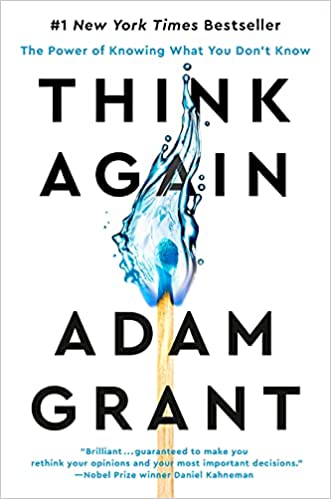Think Again — Book Summary
Introduction
Think Again was written by Adam Grant, a Wharton professor of management and psychology and best-selling author. He discusses the advantage and value of rethinking things, both in our personal and professional lives, in our interpersonal interactions, and collective actions, which can be a pathway that leads to a more fulfilling life.
Interesting quotes from the book
If knowledge is power, knowing what we don’t know is wisdom.
— Adam Grant, Think Again
We learn more from people who challenge our thought process than those who affirm our conclusions. Strong leaders engage their critics and make themselves stronger. Weak leaders silence their critics and make themselves weaker. This reaction isn’t limited to people in power.
— Adam Grant, Think Again
Thinking like a scientist involves more than just reacting with an open mind. It means being actively open-minded. It requires searching for reasons why we might be wrong—not for reasons why we must be right—and revising our views based on what we learn.
— Adam Grant, Think Again
Summary of the book Think Again
Generally, every person has some cognitive tools and learned knowledge that he/she regularly relies upon. We rely on these for different reasons. It may be because it worked the first time, we trust the person that told us ... whatever reason.
Because they are what we rely on, we rarely question them or try to consider them in-depth. This rigid adherence can result in poor outcomes, stagnant thinking, failure to learn and grow.
Rethinking, which is the process of doubting what you know, being curious about what you don't know, and updating your thinking based on new evidence, is a way of doing this.
The first chapter of the book begins with an anecdote, and then it segues into the three common mindsets coined by Phil Tetlock: preacher, prosecutor, and politician, which we constantly fall into when we engage with others or when we are in solitary conversations with ourselves.
In the preacher mindset, we are set on promoting our ideas (at the expense of listening to others). We pontificate on why we're right. In prosecution mode, we attack the ideas of others in an effort to win an argument.
Politician mode seeks the approval of others and has little conviction for the truth. We enter politician mode in order to curry favor. Grant advocates for a fourth mindset different from those found in Tetlock's model. This is the scientific model which searches for truth by testing hypotheses, regularly running experiments, and continuously uncovering new truths, and revising their thinking.
The next chapter talks about the armchair quarterback syndrome and the impostor syndrome.
The armchair quarterback (overconfidence syndrome) is when we have confidence in doing or knowing something we actually don't know or can't do, or at least not to the degree we think.
Impostor syndrome is the opposite, having too low of doubts concerning yourself and abilities. The author argues that the impostor syndrome can be even more useful and helpful than the overconfidence syndrome because then it gives you the chance to learn more and puts you in a beginner's mindset, leading us to question assumptions that others have taken for granted.
The next chapter talks about how we're defensive when our core belief is questioned, tending to shut down rather than open up. He also talked about attachment biases, where a person is attracted to his ideas that it keeps the person from recognizing when their opinions are off the mark and rethinking them.
Detachment from your ideas can help in rethinking your ideas. It can help you learn and be more flexible in your decision-making.
The next chapter then delves into a more interpersonal theme, as opposed to merely personal. The author talks about how, in working in a group, groups with 'relationship conflicts' do much worse than those with 'task conflicts'. Relationship conflicts are personal, emotional clashes, while task conflicts are more about ideas and opinions.
Relationship conflict is destructive in part because it stands in the way of rethinking. It makes us become preachers, seeing the other people as always wrong. The author talks about how sometimes disagreeableness helps in development and growth because it challenges correct views we hold about ourselves.
This then leads to Part 2, the first chapter of which begins with how to convince people to change their opinions. Approaching debates as an avenue to learn (instead of as a battle) helps in challenging opinions and rethinking. Another way is to find common ground between both extremes, which also helps the other person be more agreeable.
Asking questions instead of just stating arguments is also a good way. By asking questions, we invite the other party to join us as a partner and think for themselves.
The next chapter discusses a thorny topic: stereotypes, as well as how to persuade people to change them. Interestingly, it begins by testing hypotheses formulated on how to make rival groups agree. The hypotheses, which include things like finding common ground and considering humanity, failed. What succeeded was getting the groups to rethink the arbitrariness of their animosity.
The next chapter discusses what is called motivational interviewing. This essentially means listening to others' views. Motivational interviewing generates more openness in both directions. Listening can encourage others to reconsider their stance toward us, but it also gives us information that can lead us to question our views about them. It leads to rethinking on both sides.
Part 3 then begins, taking in a more collective bent. It discusses what is called binary bias. Binary bias asserts that the world is only divided into believers and non-believers. There are no nuances. This is not true because people's ideas on something exist in more of a spectrum than a clearly delineated line.
In talking about charged topics as a society, we must all learn to appreciate complexity.
The next chapter then goes into how traditional education methods do not help in the rethinking process. People lecture instead of interact, which doesn't help in rethinking.
Another way of encouraging thinking through ideas is
sharing passions. All these essentially help us to develop new ways of thinking. Good teachers introduce new thoughts, but great teachers introduce new ways of thinking.
In essence, just believing things we believe before will not help growth and development, and advancement. We must be willing to listen, to consider other people's views, to question our beliefs and ideas, to rethink if we must grow and learn.
Key Lessons from the Book
Lesson 1: Reconsider. You don't know it all.
As we grow older, it gets easier to fall into the trap that we know it all, or at least, most of what we need to know. This is a lie that could keep one in a stagnant mind-set. It's always a great thing to learn new things.
Lesson 2: Listening to other people and considering them objectively helps in growth as individuals.
In our interpersonal interactions and relationships, and in our collective societies, a good listening ear is invaluable.
Lesson 3: When you see that your opinion or belief or idea is wrong or less than ideal, change!
Change is the only constant in life, remain flexible, humble and remember that change is a part of growth.
Review of the book Think Again
I found the ideas in this book quite fresh, and at times, surprising. It wasn't what I would've expected at all. This book was rightly named. (Sorry to sound corny, I'm going to make a very corny statement), but it got me, thinking again. I was able to reflect a little more on my personal life. Good read, definitely!
Conclusion
As I said before, change is the only constant in life, and it is the symptom of growth. I would recommend this to anyone who is self-aware enough to see that ... "This isn't it!" If you're looking for freshness in your life, grab a copy!
Don't miss the other book summaries on SunInMe.org

